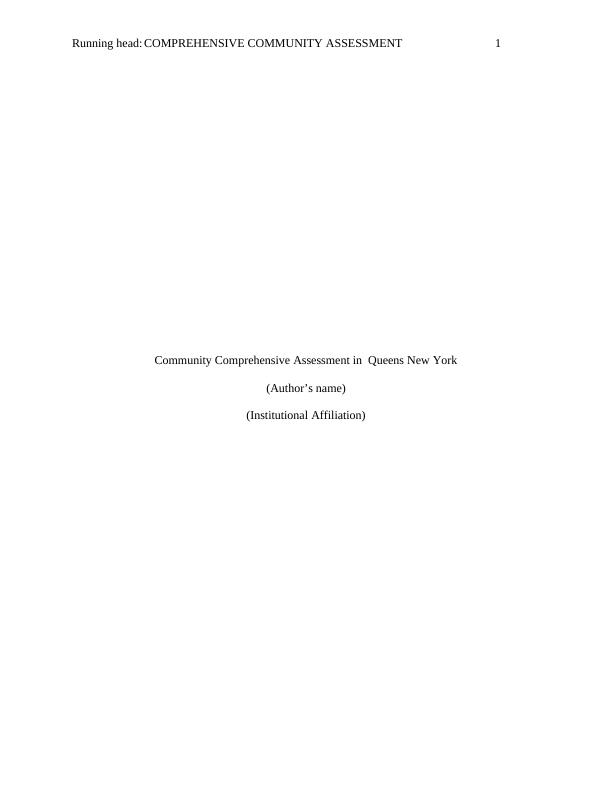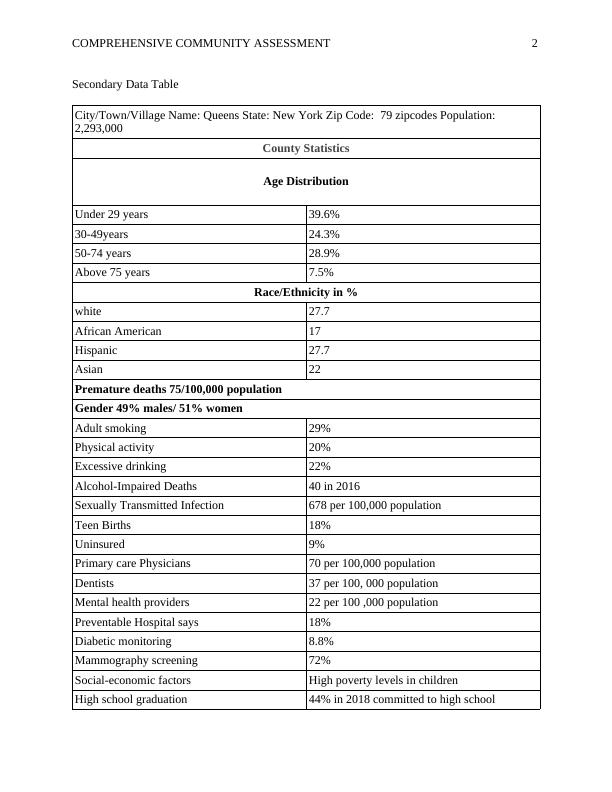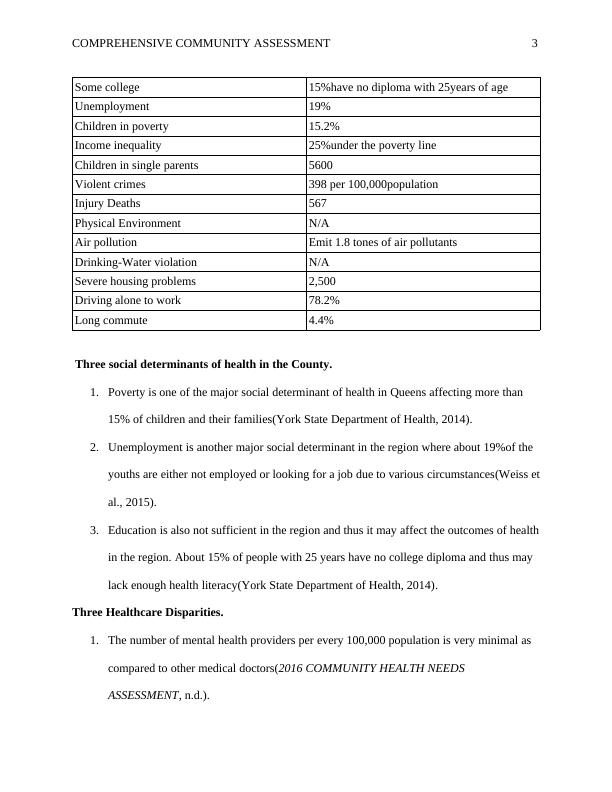Comprehensive Community Assessment in Queens New York
Added on 2022-12-18
7 Pages1506 Words64 Views
Running head: COMPREHENSIVE COMMUNITY ASSESSMENT 1
Community Comprehensive Assessment in Queens New York
(Author’s name)
(Institutional Affiliation)
Community Comprehensive Assessment in Queens New York
(Author’s name)
(Institutional Affiliation)

COMPREHENSIVE COMMUNITY ASSESSMENT 2
Secondary Data Table
City/Town/Village Name: Queens State: New York Zip Code: 79 zipcodes Population:
2,293,000
County Statistics
Age Distribution
Under 29 years 39.6%
30-49years 24.3%
50-74 years 28.9%
Above 75 years 7.5%
Race/Ethnicity in %
white 27.7
African American 17
Hispanic 27.7
Asian 22
Premature deaths 75/100,000 population
Gender 49% males/ 51% women
Adult smoking 29%
Physical activity 20%
Excessive drinking 22%
Alcohol-Impaired Deaths 40 in 2016
Sexually Transmitted Infection 678 per 100,000 population
Teen Births 18%
Uninsured 9%
Primary care Physicians 70 per 100,000 population
Dentists 37 per 100, 000 population
Mental health providers 22 per 100 ,000 population
Preventable Hospital says 18%
Diabetic monitoring 8.8%
Mammography screening 72%
Social-economic factors High poverty levels in children
High school graduation 44% in 2018 committed to high school
Secondary Data Table
City/Town/Village Name: Queens State: New York Zip Code: 79 zipcodes Population:
2,293,000
County Statistics
Age Distribution
Under 29 years 39.6%
30-49years 24.3%
50-74 years 28.9%
Above 75 years 7.5%
Race/Ethnicity in %
white 27.7
African American 17
Hispanic 27.7
Asian 22
Premature deaths 75/100,000 population
Gender 49% males/ 51% women
Adult smoking 29%
Physical activity 20%
Excessive drinking 22%
Alcohol-Impaired Deaths 40 in 2016
Sexually Transmitted Infection 678 per 100,000 population
Teen Births 18%
Uninsured 9%
Primary care Physicians 70 per 100,000 population
Dentists 37 per 100, 000 population
Mental health providers 22 per 100 ,000 population
Preventable Hospital says 18%
Diabetic monitoring 8.8%
Mammography screening 72%
Social-economic factors High poverty levels in children
High school graduation 44% in 2018 committed to high school

COMPREHENSIVE COMMUNITY ASSESSMENT 3
Some college 15%have no diploma with 25years of age
Unemployment 19%
Children in poverty 15.2%
Income inequality 25%under the poverty line
Children in single parents 5600
Violent crimes 398 per 100,000population
Injury Deaths 567
Physical Environment N/A
Air pollution Emit 1.8 tones of air pollutants
Drinking-Water violation N/A
Severe housing problems 2,500
Driving alone to work 78.2%
Long commute 4.4%
Three social determinants of health in the County.
1. Poverty is one of the major social determinant of health in Queens affecting more than
15% of children and their families(York State Department of Health, 2014).
2. Unemployment is another major social determinant in the region where about 19%of the
youths are either not employed or looking for a job due to various circumstances(Weiss et
al., 2015).
3. Education is also not sufficient in the region and thus it may affect the outcomes of health
in the region. About 15% of people with 25 years have no college diploma and thus may
lack enough health literacy(York State Department of Health, 2014).
Three Healthcare Disparities.
1. The number of mental health providers per every 100,000 population is very minimal as
compared to other medical doctors(2016 COMMUNITY HEALTH NEEDS
ASSESSMENT, n.d.).
Some college 15%have no diploma with 25years of age
Unemployment 19%
Children in poverty 15.2%
Income inequality 25%under the poverty line
Children in single parents 5600
Violent crimes 398 per 100,000population
Injury Deaths 567
Physical Environment N/A
Air pollution Emit 1.8 tones of air pollutants
Drinking-Water violation N/A
Severe housing problems 2,500
Driving alone to work 78.2%
Long commute 4.4%
Three social determinants of health in the County.
1. Poverty is one of the major social determinant of health in Queens affecting more than
15% of children and their families(York State Department of Health, 2014).
2. Unemployment is another major social determinant in the region where about 19%of the
youths are either not employed or looking for a job due to various circumstances(Weiss et
al., 2015).
3. Education is also not sufficient in the region and thus it may affect the outcomes of health
in the region. About 15% of people with 25 years have no college diploma and thus may
lack enough health literacy(York State Department of Health, 2014).
Three Healthcare Disparities.
1. The number of mental health providers per every 100,000 population is very minimal as
compared to other medical doctors(2016 COMMUNITY HEALTH NEEDS
ASSESSMENT, n.d.).

End of preview
Want to access all the pages? Upload your documents or become a member.